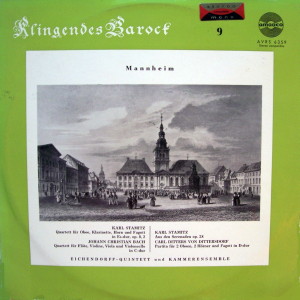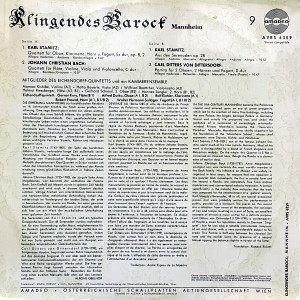 |
1 LP -
Amadeo AVRS 6359
|
 |
|
| MANNHEIM -
Klingendes Barock - 9 |
|
|
|
|
|
| Karl Stamitz: |
|
|
| 1. Quartett für
Oboe, Klarinette, Horn u. Fagott,
Es-dur, op. 8, 2 |
9' 42" |
A1 |
| - Allegro
moderato · Andante · Rondo/Allegro |
|
|
|
|
|
Johann Christian
Bach:
|
|
|
| 2. Quartett für
Flöte, Violine, Viola und
Violoncello, C-dur |
10' 07" |
A2 |
| -
Allegro · Rondeau/Grazioso |
|
|
|
|
|
Karl Stamitz:
|
|
|
| 3. Aus den
Serenaden op. 28 |
10' 52" |
B1 |
| - Allegro ·
Andante · Menuetto · Allegretto ·
Allegro · Andante · Allegro |
|
|
|
|
|
| Carl Ditters von
Dittersdorf:
|
|
|
| 4.
Partita für 2 Oboen, 2 Hörner und
Fagott, D-dur |
10' 47" |
B2 |
| -
Allegro moderato · Menuetto ·
Adagio · Menuetto · Finale
(Presto) |
|
|
|
|
|
| KAMMERENSEMBLE |
EICHENDORFF-QUINTETT |
|
| -
Momoo Kishibe, Violine (A2) |
-
Gernot Kury, Flöte (B1) |
|
-
Hatto Bayerle, Viola (A2)
|
-
Alfred Dutka, Oboe (A1, B2) |
|
-
Wilfried Boettcher, Violoncello
(A2)
|
-
Rolf Eichler, Klarinette (A1) |
|
| -
Helmut Riessberger, Flöte (A2,
B1) |
-
Robert Freund, Horn (A1, B1, B2) |
|
| -
Gerhard Schiessl, 2. Oboe (B2) |
-
Walter Hermann Sallagar, Fagott
(A1, B1, B2) |
|
| -
Hannes Sungler, 2. Horn (B1, B2) |
|
|
|
|
|
|
Luogo
e data di registrazione |
|
-
|
|
|
Registrazione:
live / studio |
|
studio |
|
|
Edizione LP |
|
AMADEO
- AVRS 6359 - (1 lp) - durata 41'
28" - (p) 1966 - Analogico |
|
|
Altre edizioni
LP
|
|
MUSICAL
HERITAGE SOCIETY - MHS 528 - (1
lp) - (1)
MUSICAL HERITAGE
SOCIETY - MHS 524 - (1 lp) - (3.
4)
MUSICAL HERITAGE
SOCIETY - MHS 545 - (1 lp) - (2)
|
|
|
Prima Edizione
CD |
|
- |
|
|
Note |
|
Stereo
compatibile
|
|
|
|
|
IN
THE 18th CENTURY
MANNHEIM became the
Palatinate capital
and entered upon an
era of great
prosperity, which
led to the erection
of many fine
buildings, including
the new Palace, the
largest baroque
Palace in Germany.
Social and artistic
life prospered too,
and under the
guidance of a
succession of
exceedingly
artistically-minded
Princes Mannheim
became the "musician's
Paradise".
Musically, Mannheim
was chiefly
important for the
foundation of the "Mannheim
School", whose chief
exponents were
Stamitz, Richter and
Holzbauer.
Karl Stamitz
(1745-1801), son of
the famous Johann
Stamitz, spent much
of his time outside
Germany. Most of his
work is
distinguished by a
blend of French
elegance and
Mozartian melody. On
the whole, this
Quartet in E flat is
conceived on
classical lines,
though the Rondo is
a distinct echo of
earlier days.
Johann Christian
Bach (1735-1782),
Anna Magdalena's
youngest son, was
certainly the most
worldly member of
the Bach family. His
influence on Mozart
was widely
recognised in later
years, for reasons
that are apparent in
this quartet. Both
movements, the first
in sonata form and
the second a Rondo,
are completely free
from archaic
mannerisms and
conventional melodic
treatment. A certain
superficiality
in the melodic flow
indicates that the
work was composed
for the
entertainment of a
“galant“ society.
Karl Stamitz's
Serenades, 48 in
all, are typical
occasional pieces,
and were probably
written for
performance in
public, possibly at
a banquet. The
pieces on this
record are a
selection from seven
of the serenades,
the variation of key
and tempo resulting
in a sort of Suite,
an excellent example
of attractive music
written for a
definite purpose.
Carl Ditters von
Dittersdorf
(1739-1799), a
contemporary of
Haydn's,
owes his reputation
mainly to German
“Singspiel“; but he
was also a notable
instrumental
composer of wit and
charm, with a very
considerable output
to his credit. This
Partita is half-way
between the
classical Sonata and
the earlier Suite,
the presence of a
second Minuet
tipping the balance
slightly in favour
of the latter.
Alfons
Übelhör
(Translation:
Richard Rickett)
|
|

